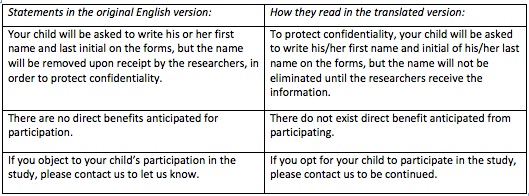¡Hola! from Kirsten Büchner of Insight Evaluation Services in Fairfax, Virginia. I am a bilingual evaluation consultant working with museums and informal learning organizations in the cultural sector. As a native Spanish speaker, I get asked to participate on projects that have components designed for Spanish-speaking audiences, so part of my job includes making sure Spanish-language consent forms and instruments accurately reflect the original English-language versions. Here are a few things to keep in mind when converting documents to another language.
Hot Tip: Whether you use a free service like Google Translate or engage a translation firm, it is always a good idea to have a native speaker with professional level experience or education review your documents and verify they are correct and make sense. Check out these examples from a consent form I recently was asked to look over:
Lesson Learned: The client had already received IRB approval for both English and Spanish forms, but the latter had to be resubmitted given the number of revisions needed. Considering the energy we evaluators put into developing valid and reliable instruments, making sure they are clear and understandable in all target languages is worth the extra effort.
Hot Tip: Translators should have current knowledge of the region(s) your respondents are from. Spanish is spoken in 20+ countries, and while we all understand the same basic language (what I like to call “broadcast Spanish”, such as what is spoken on Univision and other Spanish-language television stations), there can be important differences in vocabulary, phrasing, or how we address someone. For example, in some Central American countries and parts of Colombia, “usted” (formal you) is used when speaking with someone we are meeting for the first time or do not know well, as well as with people who are older or of higher rank; however, in Spain, Mexico and Puerto Rico, “tu” (informal you) is more commonly used.
Lesson Learned: The AEA Statement on Cultural Competence in Evaluation defines culture as “the shared experiences of people, including their languages, values, customs, beliefs, and mores. It also includes worldviews, ways of knowing, and ways of communicating.” Taking into account the way a given cultural group communicates helps us earn respect and establish trust among the members of that group, which in turn allows us to produce a higher quality evaluation.
Rad Resource: The American Translators Association lists translators by the language combination desired with advanced options to help narrow your search by specific criteria, such as education, experience and areas of expertise.
AEA Statement on Cultural Competence in Evaluation
American Translators Association
Do you have questions, concerns, kudos, or content to extend this aea365 contribution? Please add them in the comments section for this post on the aea365 webpage so that we may enrich our community of practice. Would you like to submit an aea365 Tip? Please send a note of interest to aea365@eval.org . aea365 is sponsored by the American Evaluation Association and provides a Tip-a-Day by and for evaluators.


A good resource for translating evaluation terms across English, French, and Spanish is http://www.oecd.org/dac/evaluation/2754804.pdf OECD DAC’s Glossary of Key Terms in Evaluation and Results Based Management. (OECD DAC is the Organisation for Economic Co-operation and Development, Development Assistance Committee.)
While Google Translate can often provide a good sense of what the source text means, it is NOT an tool to use when you expect a professional and accurate translation. Only a human can do that, including reflecting particular sensitivities of the speakers of the target languistic community. The results of a Google Translate must at best be verified by a qualified and experienced translator.